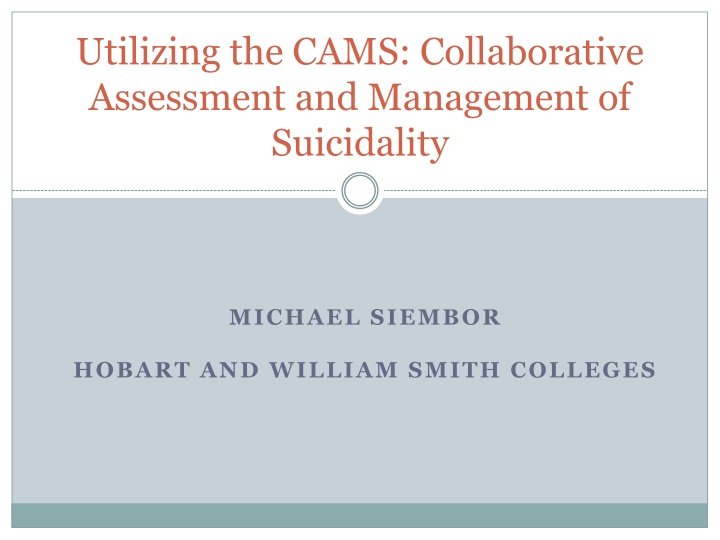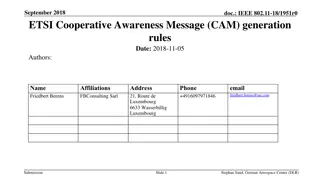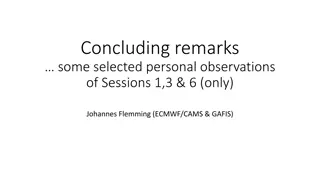
Collaborative Assessment and Management of Suicidality (CAMS)
Explore the CAMS approach, a suicide-focused therapeutic framework emphasizing assessment, treatment planning, and risk management with suicidal outpatients. Learn about the Suicide Status Form and the benefits of utilizing CAMS for comprehensive suicide risk assessment and treatment planning.
Download Presentation

Please find below an Image/Link to download the presentation.
The content on the website is provided AS IS for your information and personal use only. It may not be sold, licensed, or shared on other websites without obtaining consent from the author. If you encounter any issues during the download, it is possible that the publisher has removed the file from their server.
You are allowed to download the files provided on this website for personal or commercial use, subject to the condition that they are used lawfully. All files are the property of their respective owners.
The content on the website is provided AS IS for your information and personal use only. It may not be sold, licensed, or shared on other websites without obtaining consent from the author.
E N D
Presentation Transcript
Utilizing the CAMS: Collaborative Assessment and Management of Suicidality MICHAEL SIEMBOR HOBART AND WILLIAM SMITH COLLEGES
What Is It? CAMS is first a philosophy of care. Suicide-focused therapeutic framework a clinical platform. An overall process of clinical assessment, treatment planning, and management of suicidal risk with suicidal outpatients. Having a life worth living Marsha Linehan. Along with DBT and CBT, an evidence-based treatment for suicidal risk.
But What Is It? The CAMS is the Suicide Status Form. Three Forms: Initial Tracking Outcome Each form contains a series of suicide-specific questions completed by both the student and therapist collaboratively.
My Experience with CAMS I ve been using CAMS since 2012 No conflict of interest with David Jobes, Shawn Shea, or CAMS I ve taken David Jobes online training and read his book Managing Suicidal Risk Shawn Shea s book The Practical Art of Suicide Assessment My own style combines the CASE Approach with CAMS
When I Use CAMS CCAPS Elevations Suicide Plan, Past Attempts Safety Planning Setting boundaries/limits/therapist shopping Regular Sessions & Urgent Care Student Buy-In All students are hospitalized Staff Buy-In Common Language
Jobes Benefits Fosters a strong clinical alliance/motivation Focus is on treating suicide, independent of a mental disorder diagnosis Assesses suicide risk comprehensively Develops and maintains suicide-specific treatment plan Tracks ongoing risk Provides clinical documentation, reduces liability Allows flexibility across orientations, disciplines, clinical settings Least-restrictive approach Evidence-based
Other Benefits I See I often use this to determine whether I m going to hospitalize someone in situations that aren t clear- cut. Keeping suicidal students out of inpatient hospital settings/in school. Trying to increase student motivation and resilience. Developing alternative ways of coping. A structure to manage suicide risk. Helps with countertransference.
Jobes Three Essential Truisms Regarding Completed Suicides Most suicidal people do not want an end to their biological existence; rather, they want an end to their psychological pain and suffering. Most suicidal people tell others (including mental professionals) that they are thinking about suicide as a compelling option for coping with their pain. Most suicidal people have psychological problems, social problems, and poor methods for coping with pain. (90% of people who kill themselves have a psychiatric diagnosis).
CAMS Principles Empathy for suicidal states Listen to student s story Avoid diagnostic reductionism Empathic, narrative, noncoercive approach Avoid shame/blame Avoid threatening hospitalization Climb into skin of patient/see through their eyes Collaboration Patient is the co-author of their treatment plan Honesty Informed Consent Evidence-based intervention that usually works by 12 sessions. Why not give it a try? Can help give you a sense of purpose. Too provocative/dense? (Jobes, page 4) College students - in loco parentis
CAMS Principles (II) Focus on Suicide I would love to talk about x after suicide has been eliminated from your coping repertoire. Outpatient-Oriented trying to keep the student out of inpatient care Flexible and Non-denominational Retain your own clinical skills, clinical judgment, and own treatment approaches. Goal is to get the student to become own suicidologist There is a history, there are triggers. What factors contribute to my risk?
The Suicide Status Form This is really what I mean when I say CAMS. This is the 3-part (initial, tracking, outcome) assessment tool. The Initial SSF contains Sections A-D.
Section A: Index Assessment/Treatment Planning Jobes suggests this takes 20 minutes. Important to start this early on in session. Section A is less about suicide than Section B and more about psychological pain and suffering. Key Talking Points: I d like to use an assessment tool to help give us a deeper understanding of what s going on/your pain. It s key to help the student move along when stuck.
Assessment Variables Shneidman (1988) s cubic model of suicide Psychological Pain. Psychache, a profound and seemingly unbearable suffering. Asserts that all suicides occur when a person s psychological pain threshold is exceeded. Suicide risk is reduced by raising the pain threshold and removing the root of the pain itself. Stress. Shneidman s borrows from Henry Murray s personology. Refers to largely external pressures, stressors or demands. Perturbation (Agitation). The state of being emotionally upset, disturbed, or disquieted. Impulsive desire to do something to change the current unbearable situation. The psychological energy that is the vital and driving force behind all suicidal behaviors.
Assessment Variables (II) Hopelessness Beck cognitive triad Self, others, future Jobes references data from his research group where nonsuicidal students had more than twice as many self- reported themes of plans and goals and hopes for the future Self-hate Roy Baumeister (1990) Suicide = escape from self College Students Development/Social Comparisons Overall Risk
Self Vs. Others Intrapsychic more at risk of completing (theory). Intrapsychic less inclined to seek treatment, but more responsive when they do (Jobes data). Interpsychic more at risk of attempting (theory). Interpsychic more likely to seek care, less responsive to standard treatment (Jobes data).
Reasons for Living/Dying Based on Marsha Linehan s reasons for living RFL Themes Family, Friends, Responsibility to Others, Burdening Others, Plans and Goals, Hopefulness for the Future, Enjoyable Things, Beliefs, and Self. RFD Themes Relationships, Unburdening Others, Loneliness, Hopelessness, General Descriptors of Self, Escape in General, Escape the Past, Escape the Pain, Escape Responsibilities. Use these for Safety Planning/Protective Factors later
Wish to Live/Die Kovacs and Beck (1977) Internal Struggle Hypothesis Scores Subtract WTL-WTD WTL (+2 and +1) WTL Ambivalent (0) WTD (-1 and -2)
One Thing Self vs. Relational Realistic vs. Unrealistic Clinical Useful vs. Nonclinically Useful Those who most quickly resolved suicide risk were coded as self, realistic, clinically useful.
Predictors of Suicidal Behaviors Entrapment and past frequency of suicide attempts were the only significant predictors of prospective suicidal behaviors in a group of attempt survivors (O Connor, Smith, Ferguson, Ryan, & Williams, 2013). Entrapment results when one s attempt to escape from high stress or defeating circumstances (which can be internal or external) is blocked.
Section B: 14 Risk Factors/Warning Signs Jobes suggest this takes 10 minutes. Here I use the CASE method (Shawn Shea). Burden to others/fixed delusion.
Section C: Treatment (Safety) Planning Jobes suggests this takes 20 minutes. Identification of two suicidal drivers = issues or problems that make suicide compelling to the student. What the student says that makes them the most suicidal (e.g., Facebook checking, drinking.) The things that make suicide irresistible to you. I use this mostly for safety planning.
Section D: Case Note Serves as a fully HIPAA-compliant comprehensive medical record Documentation
To Hospitalize or Not Need for hospitalization depends on the specificity and quality of the treatment plan, commitment to the Crisis Response Plan, and overall intent to fight for life. We consult as a staff.
How to Get the CAMS https://cams-care.com Online training Book
References Jobes, D.A. (2016). Managing Suicidal Risk: A Collaborative Approach. New York, NY: The Guilford Press. O Connor, R., Smyth, R., Ferguson, E., Ryan, C., & Williams, J.M. (2013). Psychological processes and repeat suicidal behavior: A four-year prospective study. Journal of Consulting and Clinical Psychology, 81, 1137-1143. doi: 10.1037/a0033751 Shea, S. (2011). The Practical Art of Suicide Assessment. New York, NY: John Wiley & Sons.










